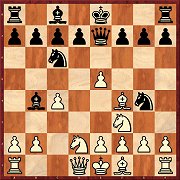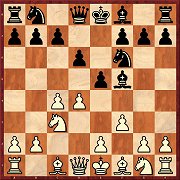19,95 €
16,76 € Sans TVA (pour les clients en-dehors de l'UE)
19,44 $ (sans TVA)
Highlights
Better than the world-champion! Sergei Karjakin for the 2nd time wins "Norway Chess" thanks to three wins in a row in the final rounds. Karjakin comments on his win over Kramnik. Other annotations have been contributed by Ftacnik, Krasenkow, Marin, Negi, Roiz, Stohl, Sumets and Szabo. In addition there are an openings survey by Mihail Marin + „Game of the day“-videos by Daniel King.
Capablanca Memorial: The game Almasi-So in the 5th round was a decisive one. His victory with Black brought the Wesley So into the lead and from then on it could not be prised out of his hands. The tournament winner has annotated that theoretically important game.
Karpov-Tournament: Tournament victor Morozevich was able to permit himself a draw in the last round because his rival Jakovenko lost his game. Jakovenko, Bologan and Sutovsky, who all took part, have annotated games
Interactive training lectures with video feedback to your ideas: Daniel King „Move by Move“, Oliver Reeh “Tactics" and Karsten Müller „Endgames“ - get on a move!
13 new opening articles with lots of new ideas for your repertoire: Viktor Moskalenko reveals more secrets of a "secondary opening" (Budapest Gambit: 1.d4 Nf6 2.c4 e5 3.dxe5 Ng4 4.Bf4 g5), Tibor Havasi presents a setup against the Caro-Kann (with 2.Nf3 and 3.Nf3), Dejan Antic shows the ideas in the "Adams-Variation" against the Sicilian (2.Nf3 e6 3.g3) and many more!
Langues:
Allemand, Anglais
Niveaux:
Joueur de tournoi
, Professionnel
Introduction by GM Karsten Müller
Opening article for free download!
Evgeny Postny: "A lot of blanks" (Nimzo-Indian with 4.f3 c5 5.d5 0-0 6.e4 d6)
 If White wants to go for a sharp position against the Nimzo-Indian the move 4.f3 is always shortlisted. In this article IGM Evgeny Postny examines the many positions that may show up on the board after 4.f3 c5 5.d5 0-0 6.e4 d6.
If White wants to go for a sharp position against the Nimzo-Indian the move 4.f3 is always shortlisted. In this article IGM Evgeny Postny examines the many positions that may show up on the board after 4.f3 c5 5.d5 0-0 6.e4 d6.
Here 7.Nge2 is preferred by most experts, in particular Sergey Volkov, who is represented in the Mega database with countless 4.f3 games, plays this (till 2003 he still used 7.Bd2). Postny now considers four moves for Black: 7...Nh5, 7.exd5, 7...Re8, and 7...b5.
After the most frequently played move 7...b5 White then moves his knight away from e2. 8.Nf4 is intended to provoke 8...e5, but it is not clear whether that is really necessary and whether it is in White’s favour at all. Thus Rainer Knaak comes to the conclusion:
"There are still a lot of blanks in the theory of this variation. As Evgeny Postny
writes, engines sometimes overrae Black’s prospects."
Download for free (CBV-file for ChessBase/Fritz)...
Load the abstract from the booklet (pdf)...
All opening articles in CBMagazine #161
Langrock: English Defence A40
1.d4 e6 2.c4 b6 3.e4 Bb7 4.Bd3

Hannes Langrock used to be a convinced adherent of the English Defence, but he has now changed sides. In his article he presents a repertoire from the point of view of White. According to Langrock’s analyses Black is faced with a difficult task after 4.Bd3!.
Moskalenko: Budapest Gambit A52
1.d4 Nf6 2.c4 e5 3.dxe5 Ng4 4.Bf4 Nc6 5.Nf3 Bb4+ 6.Nbd2 Qe7

This variation is considered slightly better for White, but Viktor Moskalenko is of a different opinion. White may usually obtain the bishop pair, but Black has a sound position in which the pawns are placed on dark squares and appropriately he possesses the light-squared bishop.
Rotstein: Old Indian Defence A53
1.d4 Nf6 2.c4 d6 3.Nc3 Bf5 4.f3 e5

Somewhat surprisingly it is not quite so simple for White to manage a slight advantage for White after 3...Bf5. The most frequently seen move is 4.f3, but, as Arkadij Rotstein shows, Black obtains a satisfactory game after 4...e5.
Karolyi: Alekhine Defence B05
1.e4 Nf6 2.e5 Nd5 3.d4 d6 4.Nf3 Bg4 5.Be2 e6

In the second part of his repertoire against the old main variation (4...Bg4) Tibor Karolyi deals with the sub-variation 5...e6. White obtains a secure advantage in all lines and in our author’s opinion should above all avoid the move h3.
Havasi: Caro-Kann B11
1.e4 c6 2.Nf3 d5 3.Nc3 Bg4 4.h3 Bxf3 5.Qxf3

This was played by Bobby Fischer, but Tibor Havasi is able to squeeze a few new subtleties out of the subject. But above all, the setup presented by the young Hungarian is extremely easy to learn and nonetheless not without its venom.
Antic: Sicilian Defence B40
1.e4 c5 2.Nf3 e6 3.g3

Michael Adams has played this several times with a good measure of success. So Dejan Antic calls it the Adams Variation. White firstly does without d3 and if need be he protects e4 with Qe2. Of course this is no way to force an advantage, but it does immediately set Black a few problems.
Szabo: Sicilian Defence B48
1.e4 c5 2.Nf3 e6 3.d4 cxd4 4.Nxd4 Nc6 5.Nc3 Qc7 6.Be3 a6 7.Qd2 Nf6 8.f4

White has for a long time been successful with 8.0-0-0, but countermeasures have been found for Black. At present it is still possible to surprise one’s opponent with 8.f4. But according to Krisztian Szabo Black should not have any great problems keeping things on a level keel.
Stohl: French Defence C18
1.e4 e6 2.d4 d5 3.Nc3 Bb4 4.e5 c5 5.a3 Bxc3+ 6.bxc3 Ne7 7.Qg4 Qc7 8.Qxg7 Rg8 9.Qxh7 cxd4 10.Ne2 Nbc6 11.f4 dxc3 12.Qd3 d4

Spurred on by the game Almasi-So (Capablanca Memorial 2014) Igor Stohl examines the modern variation with 12...d4. The results are absolutely heartening for Black and for the moment it is rather White who has to be thinking about improvements.
Krasenkow: Queen's Gambit Accepted D28
1.d4 d5 2.c4 dxc4 3.Nf3 Nf6 4.e3 e6 5.Bxc4 c5 6.Qe2 a6 7.dxc5 Bxc5 8.0-0 Nc6 9.e4

In the second part of his investigations into 6.Qe2 Michal Krasenkow comes to the critical variation with 8...Nc6. In it Black has good chances for equality but he needs to know his theory well and must also play accurately in the early middlegame.
Sumets: Queen's Indian Defence E15
1.d4 Nf6 2.c4 e6 3.Nf3 b6 4.g3 Bb4+ 5.Bd2 Bxd2+ 6.Qxd2 Ba6 7.b3

Andrey Sumets analyses the variations from White’s point of view. From the diagram the first move examined is 7...d5. But then one needs to have a good knowledge of the sharp 8.Nc3 d5 9.e4.
Postny: Nimzoindian E20
1.d4 Nf6 2.c4 e6 3.Nc3 Bb4 4.f3 c5 5.d5 0-0 6.e4 d6

Magnus Carlsen sees himself having to meet the move 4.f3 “all the time”. At the Gashimov Memorial he played 4...c5, resulting in the position in the diagram. Evgeny Postny considers Nakamura’s 7.Bd2 to be simply a side variation with the critical line being 7.Nge2.
Marin: Nimzoindian E52
1.d4 Nf6 2.c4 e6 3.Nc3 Bb4 4.e3 0-0 5.Bd3 d5 6.Nf3 b6 7.0-0 Bb7 8.cxd5 exd5 9.Ne5

This natural setup for Black is still valid. Mihail Marin tries in his extensive article to show that White has at least the more pleasant game. And he manages to do just that.
Kuzmin: King's Indian Defence E83
1.d4 Nf6 2.c4 g6 3.Nc3 Bg7 4.e4 d6 5.f3 0-0 6.Be3 Nc6 7.Nge2 a6 8.Qd2 Na5

The almost new 8...Na5 attacks a sensitive point in White’s camp – the pawn c4 – and at the same time it prepares ...b5, because if White captured twice the final move would be Na5-b3! So far White has not found a good countermeasure – a hard blow for fans of the Sämisch Variation.


 If White wants to go for a sharp position against the Nimzo-Indian the move 4.f3 is always shortlisted. In this article IGM Evgeny Postny examines the many positions that may show up on the board after 4.f3 c5 5.d5 0-0 6.e4 d6.
If White wants to go for a sharp position against the Nimzo-Indian the move 4.f3 is always shortlisted. In this article IGM Evgeny Postny examines the many positions that may show up on the board after 4.f3 c5 5.d5 0-0 6.e4 d6.











